Untitled Document
an unblinking look—in words and images—at
the reality of warfare

Dead Iraqi soldier in Gulf War. © Kenneth Jarecke
"When our troops enter a bombed village the pariah dogs are already at
work eating the corpses of the babies and old women who have been killed. Many
suffer from ghastly wounds, especially some of the younger children who...are
covered with flies and crying for water."
—Colonel Osburn of Britain, quoted in a May 1935 issue of the Manchester
Guardian. Reprinted in A History of Bombing by Sven Lindqvist (The
New Press, 2001), p 68.
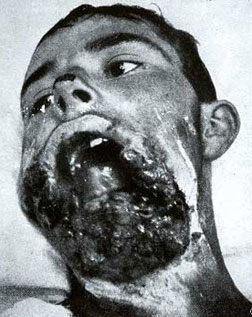
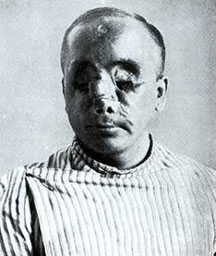
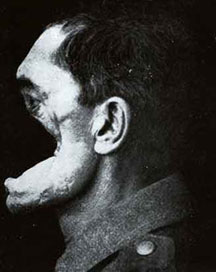
Soldiers who survived WW I. From War
Against War!
"I could watch a burned infant trying to nurse from its
dead mother's breast, see young men with their faces blown away, witness a boy
deliberately gutted...and never protest."
—reporter Richard Boyle in Vietnam. The Flower of the Dragon: The
Breakdown of the US Army in Vietnam by Richard Boyle (San Francisco, 1972),
p. 22. Reprinted in An Intimate History of Killing by Joanna Bourke
(Basic Books, 1999), p 199.
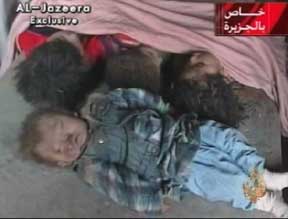

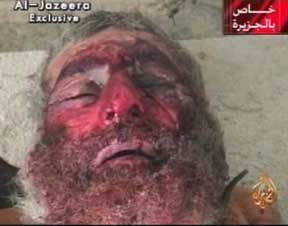

Al-Jazeera screenshots of US's post-9/11 attack on Afghanistan
"But [bombings] arouse a completely personal hate that no
one can really understand who has not huddled in a cellar or burrowed his face
in a field to escape dive bombers or seen a mother search for her son's torn-off
head or smelled the stench of burning schoolchildren."
—Reporter Edgar Snow in Chunking, China. Quoted in A
History of Bombing, p 75.
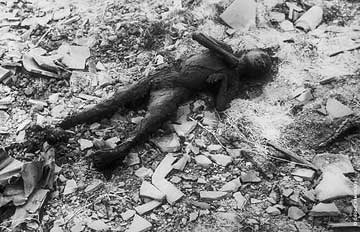
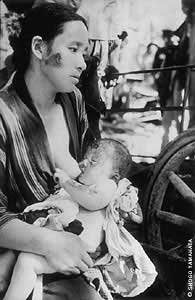
Nagasaki, Japan, 10 August 1945. © Yosuke
Yamahata
"Those poor bastards sat in the air-raid shelters of 16,000
apartment buildings that burned down. Those who followed instructions and dutifully
sat there, as I myself would have done, were all killed. They were suffocated
when the shelter filled with smoke or when the firestorm had consumed all the
oxygen. Only their bodies could testify as to how they had died.
The corpses often lay crowded into heaps near the barricaded exits.
Other bodies were stuck in the hardened black mass of their own fat, which had
melted and run out onto the floor.
The infants lay in rows like grilled chickens. Other corpses had
vanished completely; nothing was left but a fine layer of ash on the tables
and chairs.
Most of those who left the shelters burned to death out on the
street instead. Many lay facedown, with one arm over their heads, as if to shield
themselves. Many had shrunk to the size of dwarves; others had blown up like
balloons. Some seemed completely unharmed but were naked—all of their
clothes except their shoes had disappeared. Others lay with outstretched arms
and blank faces, like mannequins. Still others were totally charred. Their skulls
had burst at the temples where the brain pushed out, and their intestines bulged
out under their ribs."
—Sven Lindqvist, describing the British firebombing of Hamburg,
Germany in 1943. From his book A History of Bombing.
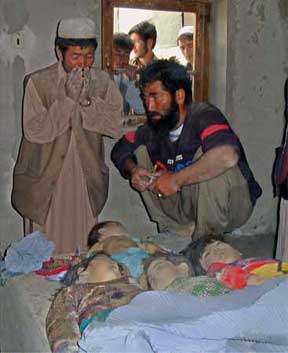
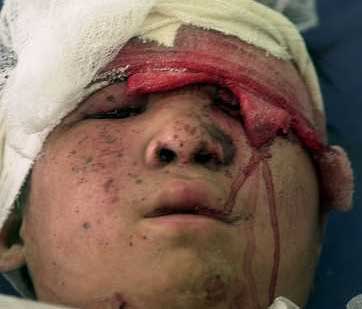
Associated Press photos of US's post-9/11 attack on Afghanistan. © AP
"Nothing but parts of bodies, arms, legs, heads, hands and
torsos, being shoveled into a big heap... Then petrol was poured over it and
the whole heap was burnt. Lorries came all the time and brought more of these
dismembered people. I became incapable of walking away. The only thing I could
think of was, could it be that Mother is among these mutilated things? Mesmerized
I stared at the heaps of human remains... Mentally, I started to put together
these parts of bodies in order to see whether they could be any of my family."
—Eva Beyer, after the firebombing of Dresden, Germany. In
The Bombers: The RAF Offensive Against Germay, 1939-1945 (1983). Quoted
in A History of Bombing, p 103.
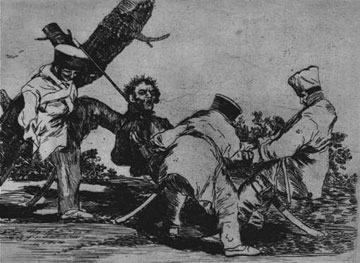
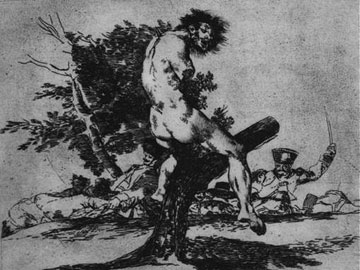
Scenes from Napoleon's Peninsular War (1807-14) from the series Disasters
of War by Francisco Goya.
"My force was standing knee-deep in mutilated bodies, surrounded
by the guttural moans of dying people, looking into the eyes of children bleeding
to death with their wounds burning in the sun and being invaded by maggots and
flies. I found myself walking through villages where the only sign of life was
a dead goat, or a chicken, or song-bird, as the people were dead, their bodies
being eaten by voracious packs of wild dogs."
—quoted in A People Betrayed: The Role of the West in
Rwanda's Genocide (Zed Books, 2000), pp 174-5.
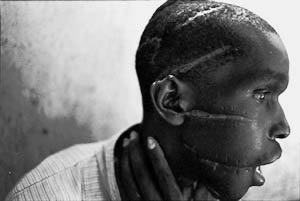
Rwanda, 1994. © James
Nachtwey
"A member of Doctors Without Borders told of rescuing
an eleven-year-old boy and his nine-year-old sister from a gang of Hutus, who
were laughing at them and spitting on them. By that time, both children had
already been raped, and their father's severed penis had been stuffed into the
girl's mouth."
—from a review of A People Betrayed: The Role of the West in Rwanda's
Genocide by L.R. Melvern (Zed Books, 2000). Reviewed in Everything
You Know Is Wrong, edited by Russ Kick (The Disinformation Company, 2002),
p 329.
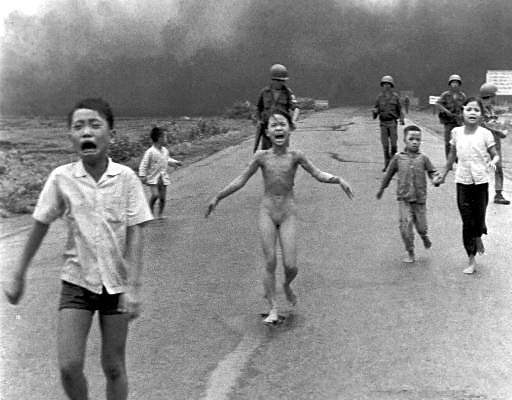
Vietnam, 8 June 1972. Photo of Kim
Phuc. © Nick Ut
"I became a fucking animal. I started fucking putting fucking
heads on poles. Leaving fucking notes for the motherfuckers. Digging up fucking
graves. I didn't give a fuck anymore. Y'know, I wanted—. They wanted a
fucking hero, so I gave it to them. They wanted fucking body count, so I gave
them body count."
—unnamed Vietnam Veteran, quoted in Achilles in Vietnam:
Combat Trauma and the Undoing of Character (New York, 1994). Reprinted in An
Intimate History of Killing.
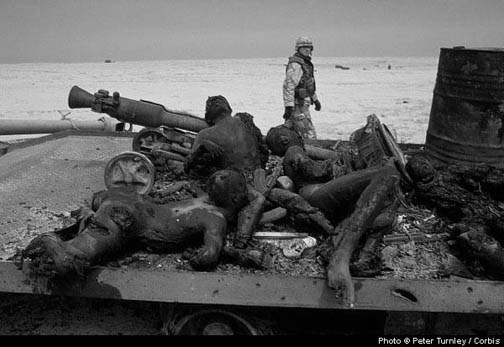
Iraq during Gulf War I. © Peter
Turnley
"Sergeant Michael McCuster recalled one time when his Marine
platoon went into a village [in Vietnam] and gang-raped a woman (the last man
to rape her, shot her). He recalled that their sergeant 'took no part in the
raid. It was against his morals. So instead of telling his squad not to do it,
because they wouldn't listen to him anyway, the sergeant went into another side
of the village and just sat and stared bleakly at the ground.'"
—from An Intimate History of Killing, p 200. McCuster's
quote is from Vietnam Veterans Against the War, The Winter Soldier Investigation
(1972), p 29.
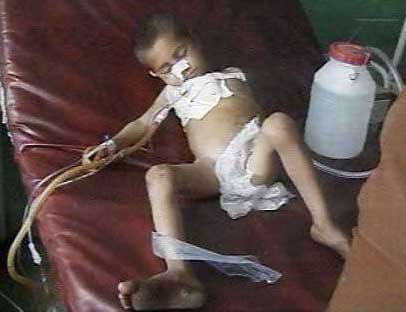
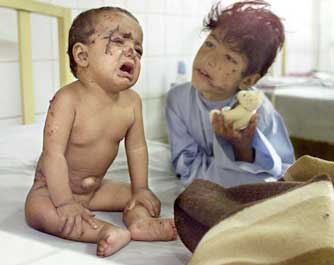
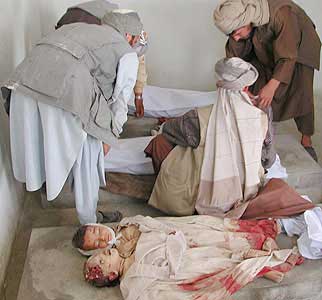
Reuters photos of US's post-9/11 attack on Afghanistan. © Reuters
"Over by the...gate lay five civilian victims on stretchers,
waiting for their coffins to arrive. They were terribly mutilated and very dirty,
for the force of the explosion had tattooed their flesh with gravel and sand.
Beside one corpse was a brand-new, undamaged straw hat. All the bodies looked
very small, very poor, and very dead, but, as we stood beside one old woman,
whose brains were soaking obscenely through a little towel, I saw the blood-caked
mouth open and shut, and the hand beneath the sack-covering clench and unclench."
—poets W.H. Auden and Christopher Isherwood, describing
a 1937 bombing attack on China by Japan. From their book Journey to a War (1939).
Quoted in A History of Bombing.
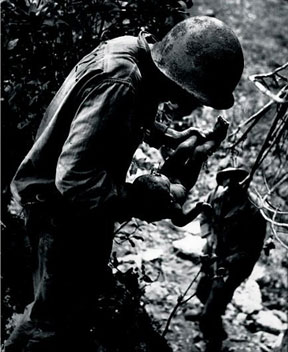
"In front of us a curious figure was standing a little
crouched, legs straddled, arms held out from his sides. He had no eyes, and
the whole of his body, nearly all of which was visible through the tatters of
burned rags, was covered with a hard black crust speckled with yellow pus....
He had to stand because he was no longer covered with skin, but with a crust-like
crackling which broke easily."
—BBC correspondent Rene Cutforth, describing the Korean War for the Manchester
Guardian (1952). Quoted in A History of Bombing.
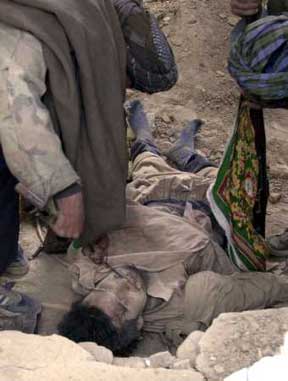
Northern Alliance soldier removing gold teeth
"In the Pacific theatre of war, men collected breasts
from the bodies of killed (or captured) Japanese women.... The tendency to collect
human trophies escalated during the conflicts in Korea and Vietnam when the
bodily parts most favoured were ears, teeth, and fingers, but the collection
of heads, penises, hands, and toes were all reported."
—From An Intimate History of Killing, PP 26-7
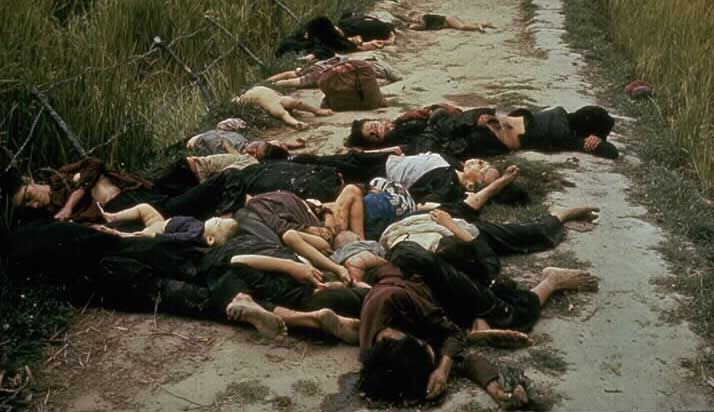
The My Lai massacre, 16 March 1968
"By the time Calley and men sat down to lunch, they had
rounded up and slaughtered around 500 unarmed civilians. Within those few hours,
members of Charlie Company had 'fooled around' and laughed as they sodomized
and raped women, ripped vaginas open with knives, bayoneted civilians, scalped
corpses, and carved "C Company" or the ace of spades onto their chests,
slaughtered animals, and torched hooches. Other soldiers had wept openly as
they fired on crowds of unresisting old men, women, children, and babies."
—description of the My Lai massacre (16 March 1968). From An Intimate
History of Killing, p 160

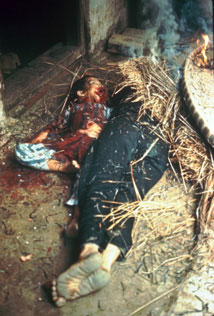
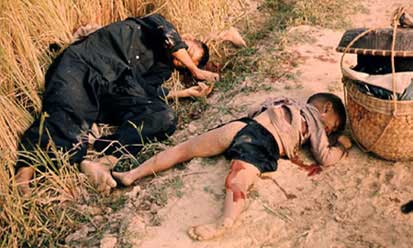
The My Lai massacre
"We heard then what sounded at first like a little girl
crying, a subdued, delicate wailing, and as we listened it became louder and
more intense, taking on pain as it grew until it was a full, piercing shriek.
The three of us turned to each other, we could almost feel each other shivering.
It was terrible, absorbing every other sound coming from the darkness. Whoever
it was, he was past caring about anything except the thing he was screaming
about."
—reporter Michael Herr in Vietnam. Dispatches (Avon,
1978), p 150
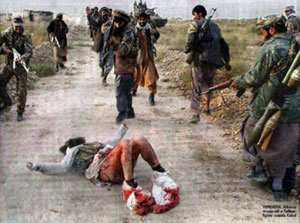
Execution by the Northern Alliance
"[Sergeant Bruce F. Anello] describes the grotesque pranks
played upon corpses, the rapes, and the way platoons were 'willing to kill any
body' simply in order to beat another platoon's 'kill record.'"
—from An Intimate History of Killing, p 205
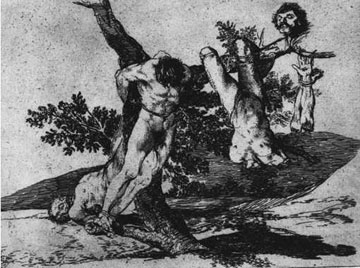
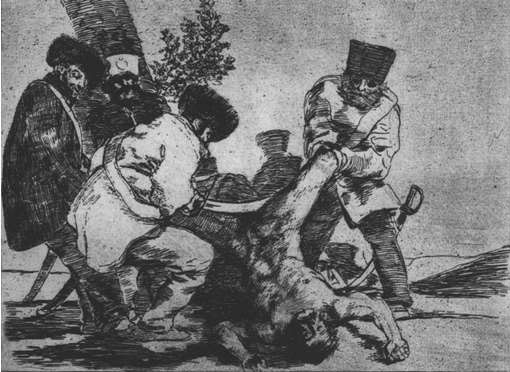
From the series Disasters of War by Francisco Goya.
"A jeep pulled up to the dump and a Marine jumped out carrying
a bunched-up fatigue jacket held out away from him. He looked very serious and
scared. Some guy in his company, some guy he didn't even know, had been blown
away right next to him, all over him. He held the fatigues up and I believed
him."
—reporter Michael Herr in Vietnam. Dispatches,
p 118.

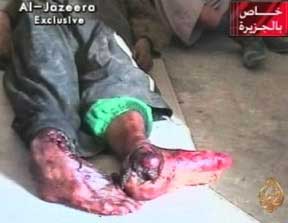
Al-Jazeera screenshots of US's post-9/11 attack on Afghanistan
"[Former Marine William Broyles] described what his men
had done to a North Vietnamese soldier whom they had recently killed. The had
propped the corpse against some C-rations, placed sunglasses across his eyes
and a cigarette in his mouth, and balanced a 'large and perfectly formed' piece
of shit on his head."
—From An Intimate History of Killing, p 3

Iraq during Gulf War I. © Peter
Turnley
"Fight, rape, war, pillage, burn. Filmic images of death
and carnage are pornography for the military man.''
—Jarhead: A Marine's Chronicle of the Gulf War and Other
Battles by former sniper Anthony Swofford (Scribner, 2003).

